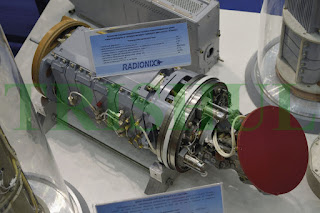Astra-1 BVRAAM
Here is the soundbyte from the Pakistan Information Minister, saying it will be the JS-10:
https://www.youtube.com/watch?v=YljgMgD5CeA
In reality, it will be the J-10CE MRCA, which is the export designation of ex-PLAAF J-10B variant, whose poster I have uploaded below. The PAF’s decision to acquire them were known last year itself, as evidenced by this video:
https://www.youtube.com/watch?v=exj8iYUkh5o
In fact, I had written late last year itself in FORCE magazine that a PAF contingent had arrived in November 2020 at the PLAAF’s flight-test/evaluation & operational conversion air base at Dingxin (40.4014015 N, 99.7893982 E) for operational conversion to the J-10B, which uses the KLJ-7 (Type-1478) MMR developed by CETC’s 14th Research Institute (also known as the Nanjing Research Institute of Electronic Technology, or NRIET). The KLJ-7’s look-up detection range is 105km and look-down range is 85km, and it offers only 14 modes of operation. Efforts by the PAF to procure the Grifo-S7 (on the JF-17) for the J-10B have been unsuccessful. The PAF wanted this MMR as it has more than 30 different operational modes offered to support air-to-air and air-to-surface missions, and navigation. Utilising low, medium and high PRF for optimal target detection in any clutter condition, and incorporating adaptive pulse compression technology, this air-cooled MMR has a scanning coverage +/-60 degrees in both azimuth and elevation, weighs less than 120kg and has a MTBF in excess of 220 hours. Look-up detection range is 150km, while look-down range is 100km. Up to 10 targets can be tracked in TWS mode.The PL-10E SRAAM (see uploaded poster above) is in reality a re-engineered variant of the LUCH-developed ‘Gran’ (Verge) from Ukraine. The latter was first showcased back in 2006. The Gran incorporates a PR-611 combined aerodynamic and gas dynamic control system. The missile is 2.5 metres long, 170mm in diameter, weighs 105kg and its aerodynamic scheme uses cruciform wings of long chord and narrow span, plus cruciform tail surfaces—all also found on the PL-10E, which is intended to allow all-aspect engagement of highly manoeuvrable airborne targets (up to 12 G) flying at speeds of up to 1,500 Knots and altitudes of 65,000 feet. It can be launched from aircraft flying at 350-1,350 Knots, and has a maximum flight-time of 25 seconds and has a maximum range of 20km and a minimum range of 300 metres during rear-hemisphere attacks. The PL-10E features a multi-element, two-colour thermal imaging IR seeker with a 180-degree look angle and 120-degree/second track rate. High agility is provided by using body lift and thrust vector control. The inertial measurement unit (IMU) can handle up to +/-500 degrees/second) G-loads and linear accelerations up to 30 G.The PL-12 BVRAAM (not the PL-15, which is not integrated with any J-10 variant) for the J-10B is equipped with active radar-homing seeker developed by Radionix of Ukraine (see uploaded poster below). It uses a dual-thrust solid rocket motor and can exceed Mach 4 and endure 38 G. The missile’s omnidirectional sensors are accurate to within 1 metre. Its active radar seeker is the Ka-band ‘Onyx’ from Radionix, which has a range of 25km, search area of +/-40 degrees in azimuth and elevation and offers “fire-and-forget” capabilities. It has a 24kg warhead and uses a radio proximity fuse. Initial versions of the PL-12 had used the Russia-origin Agat/Istok 9B-1350E Ku-band seekers. All the above-mentioned data had been published in the November 2021 issue of FORCE magazine.
Now to the most important data: Due to national financial bankruptsy, the PAF has been unable to secure product-support from the US for its F-16 fleet and consequently fleet cannibalisation is now being resorted to. At the same time, since Russia has not authorised China to re-export AL-31FN turbofans, China is LEASING the J-10Bs to the PAF, i.e. the PAF will not be the owner of the J-10Bs and they will be returned after China starts delivering the twin-engined Shenyang FC-35s to the PAF by 2025. This now has resulted in a severe air-defence vulnerability/gap that the PAF cannot address/fill and it is precisely due to this that the Pakistan Army has had to induct HQ-9P/FD-2000 HIMADS and LY-80E LOMADS for securing its own air-defence requirements, instead of relying on the PAF.
No variants of the FWS-10 turbofan are in service with any China-developed MRCA since the turbofan is still plagued by compressor-blade failures. Same goes for the low-TBOs (less than 80 hours) of the TVC nozzles (compared to 200 hours of those of the Su-30MKI). Hence the PAF J-10Bs won’t have them on-board, contrary to what several internet fanboys are speculating about.



















































